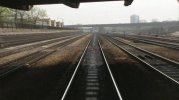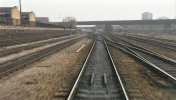Hi all
Just watching the NSE Cabride video filmed in early 1991 on the Up Relief from Reading to Paddington - really takes me back to my childhood! My question is whether anyone could shed any light on the purpose of what appear to be short sections of rail attached to the sleepers in the four-foot? I have done a quick search but as I have no idea what they are for I'm not having much luck finding answers.
They appear quite frequently - see attached pics from Portobello Junction near Westbourne Park - first on adjacent DR to the right of shot and second on UR ahead of the train.


TIA
Chris
Just watching the NSE Cabride video filmed in early 1991 on the Up Relief from Reading to Paddington - really takes me back to my childhood! My question is whether anyone could shed any light on the purpose of what appear to be short sections of rail attached to the sleepers in the four-foot? I have done a quick search but as I have no idea what they are for I'm not having much luck finding answers.
They appear quite frequently - see attached pics from Portobello Junction near Westbourne Park - first on adjacent DR to the right of shot and second on UR ahead of the train.


TIA
Chris
